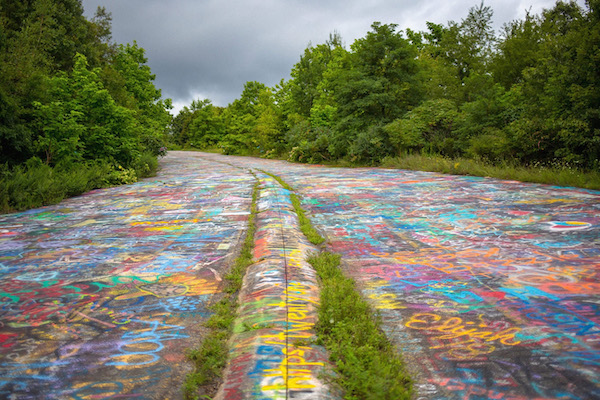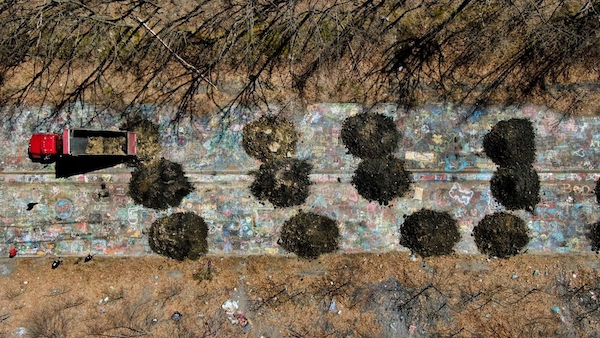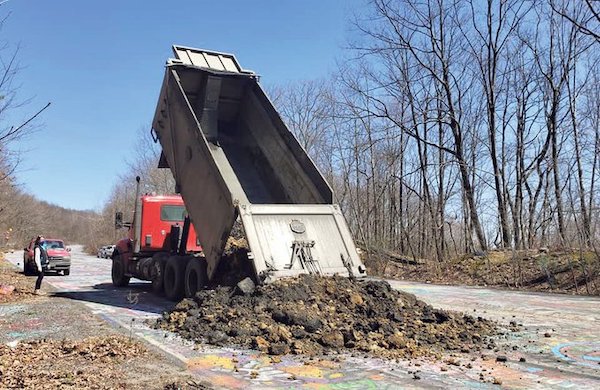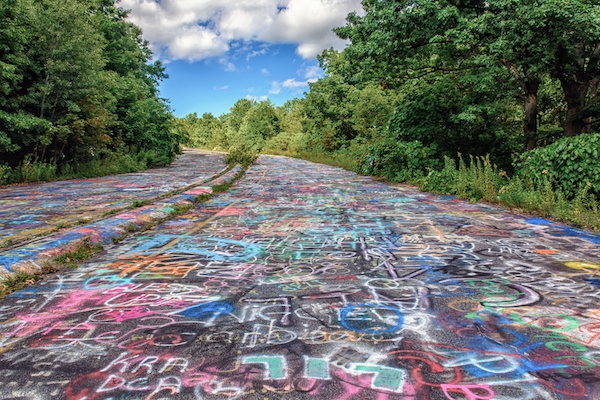On April 8th of this year, Fox News reported that Pennsylvania’s famed Graffiti Highway was being completely covered with truckloads of dirt. The one-mile stretch of Route 61 was abandoned in 1993 after an underground fire in the nearby abandoned mining town of Centralia caused the highway to buckle and collapse. Despite the danger, the highway became popular with tourists who left behind both crude and sophisticated graffiti. Over the years, thousands of visitors have created one of the largest collective artworks in the country and to many Graffiti Highway is an attractive expression of unfettered populist art. Its urban vibe clashes with the Pennsylvania countryside, yet it remains a cultural destination—even CNN trumpeted that “artists have found a new use for this abandoned highway.” Still, it has its detractors—a local Twitter user @agirlnamednick calls the highway “just a bunch of penises and empty beer cans.”

Photo by Alexandra Chairman.
The property owner always had plans to destroy the highway in order to prevent “more damage to the community.” But, with no community around to be damaged, erasing Graffiti Highway didn’t seriously begin until groups of people showed up during Pennsylvania’s pandemic lockdown. “It’s ridiculous,” said Tom Hynoski, county emergency management agency director. “They’re supposed to be staying home due to the COVID-19 but they’re coming from New York and New Jersey to be here.” Since the state of Pennsylvania isn’t too keen on taggers from other states arriving to spread disease, it mandated that Graffiti Highway be destroyed. This is understandable but misguided, for the problem is the mindset of the visitors, not the highway itself.

New York Times Magazine writer Jenna Wortham recently tweeted, “Everything unsettling that is happening right now… is about power.” Consequently, visitors to the vanishing Graffiti Highway who equate caution with restriction bemoan its destruction as the act of an authoritarian Nanny State. To challenge that control through democratic processes, a petition was initiated designating the highway an official state historic landmark; something that would, ironically, bring even more potential COVID-19 infectors. With such an absurd proposal, it was decided to solve the problem by eradicating the highway rather than try to keep people away from it, especially when online reviewers hype the potentially fatal act of visiting the highway as an opportunity to have “fun with a side of sad and creepy.”

Social Darwinism is a theory that applies biological concept to sociology and politics. Under such theories, individuals not observing correct protocol lose their membership in the collective, either through death or ostracization. So, if people want to risk catching COVID-19 by visiting a tourist trap or not wearing a mask, that’s okay. The problem is, there are unacceptable repercussions for other members of the group, as @Joanne1225 tweets, “Thanks to the stupidity of several hundred people who came here during the pandemic, Graffiti Highway is gone forever.” Oh well, Vita longa, graffiti brevis.


